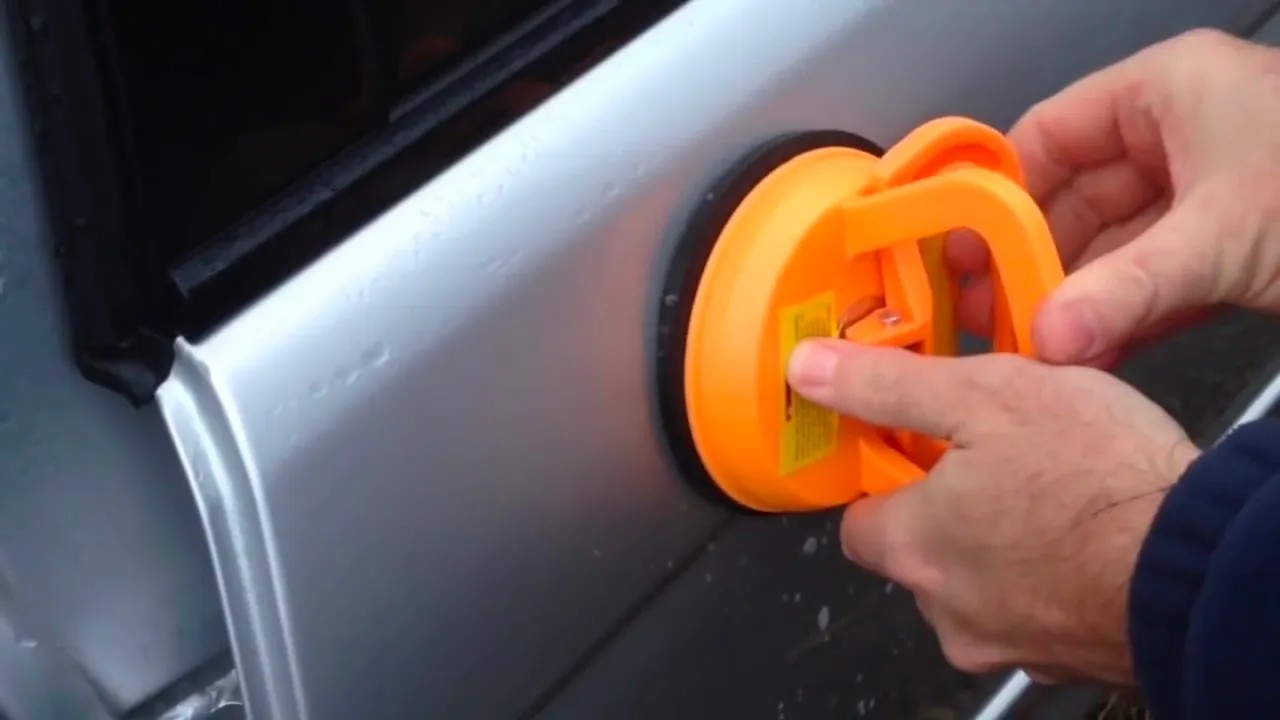Car dents and dings are unfortunately a common part of vehicle ownership. Whether it’s a minor ding you just noticed or a more significant dent, one of the first questions that comes to mind is about repair costs. Understanding how much it costs to fix a car dent is crucial for making informed decisions about vehicle maintenance and budgeting. This guide will walk you through the different types of dents, repair options, and what you can expect to pay to restore your car’s appearance.
Understanding Car Dents and Dings
Before diving into costs, it’s important to distinguish between car dings and dents. While both are imperfections on your vehicle’s body, they differ in severity and repair methods.
Dings vs. Dents: What’s the Difference?
A ding is generally considered a minor, shallow indentation on your car’s surface. Often caused by small objects like hail, pebbles, or stray shopping carts lightly bumping into your car, dings are usually less than an inch in diameter and don’t significantly distort the metal. They might be barely noticeable and sometimes can be fixed with simple DIY techniques.
On the other hand, a dent is a more substantial deformation. Dents are typically larger, deeper, and caused by more forceful impacts, such as collisions with other vehicles, hitting poles, or even significant hail storms. Dents often distort the car’s body lines and may require professional repair to restore the vehicle’s original shape.
Why Repairing Dents Matters
You might be tempted to ignore a small dent or ding, especially if it seems minor. However, addressing these issues promptly is important for several reasons:
- Preventing Rust: Even small dents can compromise the car’s paint and protective coating. Once this barrier is broken, moisture and air can reach the bare metal, leading to rust formation. Rust can spread and cause significant structural damage over time, costing much more to repair in the long run.
- Maintaining Paint Integrity: Leaving dents unrepaired can lead to paint damage around the affected area. The paint might crack, peel, or fade, further diminishing your car’s appearance and potentially leading to more extensive and expensive paint repairs later.
- Preserving Resale Value: Visible dents and dings negatively impact your car’s resale value. Potential buyers often perceive body damage as a sign of neglect or more serious underlying issues. Repairing dents demonstrates that you’ve taken good care of your vehicle, making it more attractive to buyers and helping you secure a better price when you decide to sell or trade it in.
DIY Car Dent Repair: Is It Right for You?
For minor dings and shallow dents, DIY repair methods can be an appealing and cost-effective option. One popular DIY approach involves using car dent pullers.
Car Dent Pullers Explained
Car dent pullers are tools designed to help you remove small dents without the need for extensive bodywork. They typically work by using suction cups or adhesive tabs that attach to the dented area. By applying pulling force, the tool attempts to pop the dent back to its original position.
There are two main types of dent pullers:
- Suction Cup Pullers: These use a rubber suction cup to create a vacuum seal on the dent. You then use a handle or lever to pull the dent outwards. They work best on smooth, clean surfaces and are generally effective for shallow, broad dents.
- Adhesive Tab Pullers: These kits come with plastic tabs that you glue to the dent using hot glue. Once the glue sets, you attach a puller tool to the tab and use it to extract the dent. Adhesive pullers can be more effective on dents with sharper contours or in areas where suction cups might not adhere well.
How to Use a Dent Puller
Using a dent puller is generally straightforward, but it’s crucial to follow the manufacturer’s instructions carefully. Here’s a general step-by-step guide:
- Clean the Dent Area: Thoroughly clean the dent and the surrounding area with soap and water, then dry it completely. This ensures proper adhesion for both suction cup and adhesive pullers.
- Prepare the Puller: For suction cup pullers, make sure the cup is clean and slightly moistened for better suction. For adhesive pullers, heat the glue sticks and apply glue to the plastic tab.
- Attach the Puller: Position the suction cup or adhesive tab directly in the center of the dent. Press firmly to create a good seal or allow the adhesive to bond securely.
- Pull the Dent Out: Gradually and gently apply pulling force using the tool. Avoid sudden, forceful pulls, as this could damage the paint or surrounding area. You may need to repeat the pulling process several times, working slowly to coax the dent out.
- Remove the Puller: Once the dent is removed or significantly improved, carefully detach the suction cup or remove the adhesive tab (usually by gently twisting or using a release agent included in the kit).
- Clean Up: Remove any adhesive residue with the recommended solvent and clean the area again.
Pros and Cons of DIY Dent Repair
Pros:
- Cost-Effective: DIY dent repair kits are significantly cheaper than professional repairs. Kits typically range from $20 to $100, making them an attractive option for budget-conscious car owners.
- Convenience: DIY repair can be done at home, at your own pace, without needing to schedule appointments or leave your car at a body shop.
- Quick Fix for Minor Damage: For small, shallow dents, DIY methods can provide a quick and satisfactory solution.
Cons:
- Effectiveness Limitations: DIY dent pullers are not effective for all types of dents. They work best on shallow, easily accessible dents on flexible panels. Creased dents, dents on edges or reinforced areas, or dents with paint damage are less likely to be successfully repaired with DIY methods.
- Risk of Further Damage: Improper use of dent pullers can potentially worsen the dent, damage the paint, or even cause further panel distortion. It’s essential to be gentle and patient and to follow instructions carefully.
- Quality of Results: DIY repairs may not always achieve the same level of perfection as professional repairs. There might be slight imperfections or remaining痕迹 visible after DIY attempts.
Professional Car Dent Repair: When to Seek Expert Help
For larger, more complex dents, or when you prioritize a flawless finish, professional dent repair is the recommended route. Auto body shops and specialized dent repair services offer various techniques, including paintless dent repair (PDR) and traditional bodywork.
Types of Professional Dent Repair
- Paintless Dent Repair (PDR): PDR is a specialized technique that removes dents without damaging the car’s paint finish. Technicians use specialized tools to gently massage and manipulate the metal from behind the panel, gradually pushing the dent back to its original shape. PDR is ideal for dents that are not too deep and where the paint is intact. It’s often faster and more affordable than traditional bodywork.
- Traditional Bodywork: For more severe dents, dents with paint damage, or dents in areas that are not accessible for PDR, traditional bodywork methods are used. This typically involves filling the dent with body filler, sanding it smooth, and then repainting the affected area to match the original color. Traditional bodywork is more labor-intensive and costly than PDR but can restore heavily damaged panels to their original condition.
Benefits of Professional Repair
- Expertise and Skill: Professional technicians have the training, experience, and specialized tools to handle a wide range of dent types and sizes effectively.
- High-Quality Results: Professional repairs aim for a seamless, factory-like finish, ensuring the dent is completely removed and the paint is perfectly matched.
- Comprehensive Service: Body shops can address not only the dent itself but also any associated paint damage, rust issues, or structural concerns.
- Warranty and Guarantee: Reputable body shops often provide warranties or guarantees on their repair work, giving you peace of mind.
Cost Breakdown: How Much Does Dent Repair Cost?
The cost to fix a car dent can vary significantly depending on several factors. Understanding these factors will help you estimate the potential expense and make informed choices.
Factors Influencing Dent Repair Costs
- Size and Depth of the Dent: Larger and deeper dents generally cost more to repair because they require more time, labor, and potentially more materials.
- Location of the Dent: Dents in easily accessible areas are typically cheaper to repair than dents in труднодоступных locations, such as along edges, curves, or reinforced panels.
- Type of Dent: Simple, rounded dents are usually less complex to repair than creased dents, dents with sharp edges, or dents that have stretched the metal.
- DIY vs. Professional Repair: DIY dent repair is always cheaper upfront, but professional repair guarantees expertise and quality.
- Paint Damage: If the dent has damaged the paint, the repair cost will increase significantly, especially if repainting and color matching are required.
- Repair Method: PDR is generally less expensive than traditional bodywork.
- Shop Rates and Location: Labor rates vary between repair shops and geographic locations. Shops in urban areas or dealerships typically have higher rates than independent shops in rural areas.
DIY Dent Repair Costs
As mentioned earlier, DIY dent repair kits range from $20 to $100. This cost primarily covers the dent puller tool and any included accessories like adhesive tabs or glue sticks. However, remember to factor in potential risks. If you damage your car further during DIY attempts, you might end up incurring even higher professional repair costs.
Professional Dent Repair Costs
Professional dent repair costs are much more variable. Here’s a general cost range to expect:
- Small to Medium-Sized Dents (PDR Possible): For minor dents that can be repaired using PDR, costs can range from $50 to $150 per dent.
- Larger or More Complex Dents (Traditional Bodywork): For larger dents, dents requiring body filler and repainting, or dents in difficult locations, costs can range from $200 to $500 or even $1000+ per panel. Extensive damage requiring panel replacement and full repainting can reach thousands of dollars.
To get an accurate estimate, it’s always best to get quotes from multiple reputable auto body shops in your area. They will assess the damage in person and provide a detailed breakdown of the repair costs.
Should You Fix Your Car Dent?
Deciding whether to fix a car dent is a personal choice that depends on your priorities and circumstances.
- Consider the Severity: For minor dings that are barely noticeable and don’t pose a rust risk, you might choose to leave them. However, for larger, more visible dents, or dents that could lead to rust, repair is advisable.
- Think About Resale Value: If you plan to sell or trade in your car in the future, repairing dents is a worthwhile investment to maintain its value and appeal to potential buyers.
- Assess Your Budget: Evaluate your budget and compare the cost of repair options. DIY might be suitable for minor damage if you’re comfortable with it, but professional repair is often the better choice for significant dents or when you want a guaranteed high-quality result.
Now You’re Ready…
Understanding how much it costs to fix a car dent involves considering the type and severity of the damage, your repair options, and the factors influencing pricing. Whether you opt for a DIY approach for minor imperfections or seek professional help for more significant dents, being informed empowers you to make the best decision for your vehicle and budget. When in doubt, consulting with a professional auto body shop is always a wise step to get a precise assessment and ensure your car is restored to its best condition.

